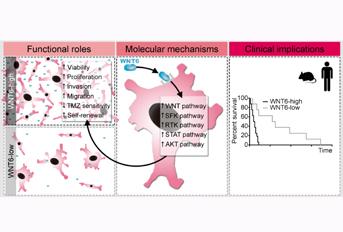Associação Portuguesa de Investigação em Cancro
WNT6 is a novel oncogenic prognostic biomarker in human glioblastoma
WNT6 is a novel oncogenic prognostic biomarker in human glioblastoma

Authors and Affiliations:
Gonçalves CS1,2, Vieira de Castro J1,2, Pojo M1,2, Martins EP1,2, Queirós S1,2, Chautard E3,4, Taipa R5, Pires MM5, Pinto AA6, Pardal F7, Custódia C8, Faria CC8,9, Clara C10, Reis RM1,2,10, Sousa N1,2, Costa BM1,2.
1 Life and Health Sciences Research Institute (ICVS), School of Medicine, University of Minho, Campus Gualtar, 4710-057 Braga, Portugal.
2 ICVS/3B's - PT Government Associate Laboratory, Braga/Guimarães, Portugal.
3 Université Clermont Auvergne, INSERM, U1240 IMoST, 63000 Clermont Ferrand, France.
4 Pathology Department, Université Clermont Auvergne, Centre Jean Perrin, 63011 Clermont-Ferrand, France.
5 Neuropathology Unit, Department of Neurosciences, Centro Hospitalar do Porto, Porto, Portugal.
6 Department of Neurosurgery, Hospital Escala Braga, Sete Fontes - São Victor 4710-243 Braga, Portugal.
7 Department of Pathology, Hospital Escala Braga, Sete Fontes - São Victor 4710-243 Braga, Portugal.
8 Instituto de Medicina Molecular, Faculdade de Medicina, Universidade de Lisboa, Lisbon, Portugal.
9 Neurosurgery Department, Hospital de Santa Maria, Centro Hospitalar Lisboa Norte (CHLN), Lisbon, Portugal.
10 Molecular Oncology Research Center, Barretos Cancer Hospital, Barretos - S. Paulo, Brazil.
Abstract:
Glioblastoma (GBM) is a universally fatal brain cancer, for which novel therapies targeting specific underlying oncogenic events are urgently needed. While the WNT pathway has been shown to be frequently activated in GBM, constituting a potential therapeutic target, the relevance of WNT6, an activator of this pathway, remains unknown. Methods: WNT6 protein and mRNA levels were evaluated in GBM. WNT6 levels were silenced or overexpressed in GBM cells to assess functional effects in vitro and in vivo. Phospho-kinase arrays and TCF/LEF reporter assays were used to identify WNT6-signaling pathways, and significant associations with stem cell features and cancer-related pathways were validated in patients. Survival analyses were performed with Cox regression and Log-rank tests. Meta-analyses were used to calculate the estimated pooled effect. Results: We show that WNT6 is significantly overexpressed in GBMs, as compared to lower-grade gliomas and normal brain, at mRNA and protein levels. Functionally, WNT6 increases typical oncogenic activities in GBM cells, including viability, proliferation, glioma stem cell capacity, invasion, migration, and resistance to temozolomide chemotherapy. Concordantly, in in vivo orthotopic GBM mice models, using both overexpressing and silencing models, WNT6 expression was associated with shorter overall survival, and increased features of tumor aggressiveness. Mechanistically, WNT6 contributes to activate typical oncogenic pathways, including Src and STAT, which intertwined with the WNT pathway may be critical effectors of WNT6-associated aggressiveness in GBM. Clinically, we establish WNT6 as an independent prognostic biomarker of shorter survival in GBM patients from several independent cohorts. Conclusion: Our findings establish WNT6 as a novel oncogene in GBM, opening opportunities to develop more rational therapies to treat this highly aggressive tumor.
Journal: Theranostics. 2018 Sep 9;8(17):4805-4823. doi: 10.7150/thno.25025. eCollection 2018.
Link: http://www.thno.org/v08p4805.htm






